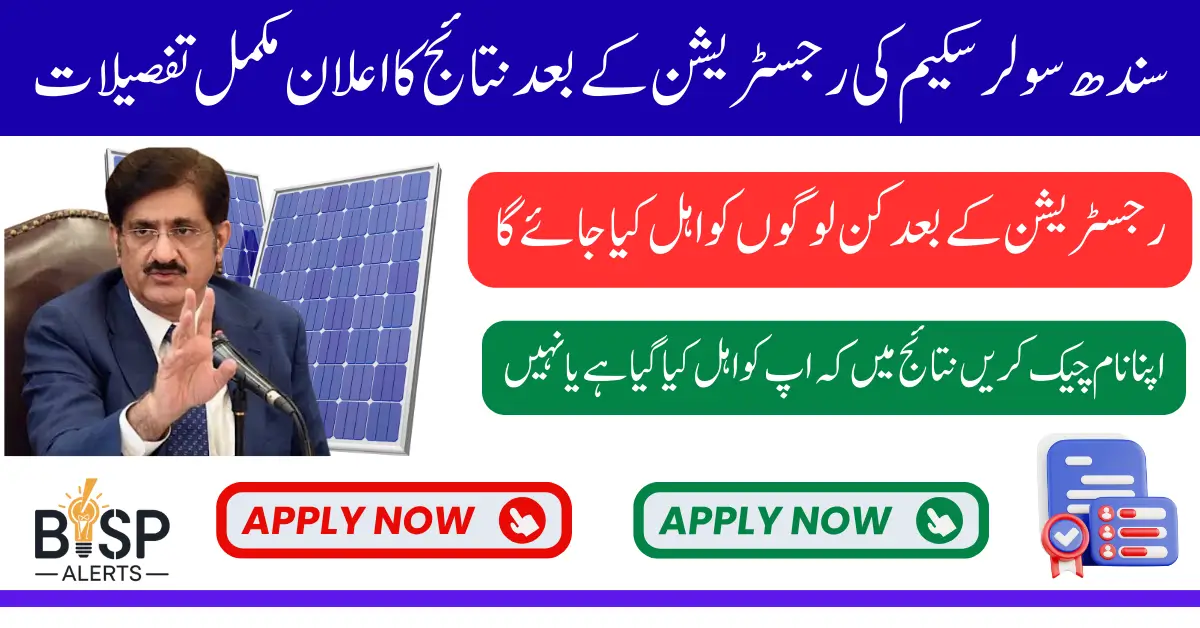Sindh Solar Scheme 2025
Sindh Solar Scheme 2025 has generated a wave of excitement among households across the province. With electricity prices climbing steadily and frequent load-shedding affecting daily life, families were waiting anxiously for the announcement of the balloting results. This scheme, launched by the Sindh government, is aimed at providing affordable solar energy solutions to low- and middle-income families who struggle to manage high bills. By offering subsidized or free solar systems, the government not only reduces the financial pressure on households but also encourages the use of clean and renewable energy.

The program mainly provides grid-tied solar systems that come with panels, inverters, and supporting structures. In some specific areas where outages are longer, batteries may also be included, while net metering will be facilitated wherever the policy allows. This approach ensures that families can generate their own electricity, reduce their monthly expenses, and even sell excess energy back to the grid.
You Can Also Read: 8171 Web Portal Ehsaas Program Registration
Sindh Solar Scheme 2025 at a Glance
The Sindh Solar Scheme 2025 has been designed to make solar adoption easier, transparent, and affordable. Below is a quick summary for readers who want the main details at a glance:
- Focus Topic: Sindh Solar Scheme 2025 Balloting Result
- Main Goal: To provide subsidized or free solar systems to eligible families in Sindh
- Package Details: 1–3 kW grid-tied systems with inverter, panels, and structure (batteries only where specified)
- Eligibility Criteria: Sindh domicile, residential consumer, monthly usage of 200–300 units, no prior subsidized solar connection
- Balloting Method: Computerized and transparent draw conducted on a district basis
- Where Results Are Available: Sindh Energy Department website, CM Sindh portal, and partner bank portals
- Verification Required: CNIC number along with 14-digit electricity bill reference number
- Estimated Savings: 1 kW system can save around Rs 6,000–9,000 per month depending on tariff rates
You Can Also Read: Ehsaas Program 8171 Online CNIC Check
How to Check Sindh Solar Scheme 2025 Balloting Result
The Sindh government has kept the result-checking process user-friendly and transparent so that every applicant can quickly find out their status. As soon as results are published, they are uploaded to official government websites and portals of partner banks. Applicants can check the outcome by visiting the portal and entering the required details.
To check the results, applicants need to visit the Sindh Energy Department official portal, the CM Sindh website, or a partner bank’s page. Once there, they should locate the “Balloting Result” or “Check Status” section. The system will ask for the applicant’s CNIC number (without dashes) and the 14-digit electricity bill reference number. In some cases, a mobile number may also be requested for OTP verification. Once the details are confirmed, the status will appear, showing whether the applicant is selected or not.
In case the website does not load due to heavy traffic, applicants are advised to try again later during non-peak hours, use a different browser, or switch to incognito mode. Saving or taking a screenshot of the result status is important so that applicants have a record for future reference.
You Can Also Read: BISP Kafalat Program Payment Increase 2025
Who is Eligible and What Documents Are Required
The Sindh Solar Scheme is focused on ensuring that subsidies are provided to genuine domestic consumers who truly need support. Therefore, clear eligibility criteria have been set.
Eligibility Conditions:
- Applicant must hold a Sindh domicile and possess a valid CNIC.
- Only domestic consumers under the residential tariff are allowed.
- Monthly electricity consumption should be around 200–300 units.
- Households that already have subsidized solar systems or net metering on the same connection cannot apply.
Required Documents for Verification:
- Copy of the applicant’s CNIC.
- Latest electricity bill with the reference number visible.
- Proof of residence or property ownership document.
- Registered mobile number for communication and OTP verification.
- Optional additional documents such as rooftop photographs, consumption history, or an affidavit in case of shared meters may also be asked for faster approval.
These requirements are set to make sure that the scheme benefits deserving families and prevents misuse of subsidies.
You Can Also Read: Apni Zameen Apna Ghar Program Officially Registration
Next Steps After Selection In Sindh Solar Scheme 2025
Households that appear on the winners list should be prepared for the next stages of the process. Once selected, applicants will undergo a verification and installation procedure that ensures fairness and transparency.
First, the applicant will receive a verification call followed by a possible field visit by officials. The purpose is to confirm the applicant’s identity, household details, and eligibility. Next, engineers will conduct a technical site survey where they will check rooftop suitability, wiring, shading, and overall structure. After that, an agreement will be signed, which includes details about the subsidy portion, installment terms, and warranty coverage.
The installation process usually takes 30 to 90 days depending on the vendor’s availability and district logistics. In districts where net metering is allowed, vendors will also guide households in applying for it. This means that families can not only save money on their bills but also generate income by selling excess electricity to the grid.
You Can Also Read: BISP Biometric Retail Disbursement Check Status
Benefits and Real-Life Impact In Sindh Solar Scheme 2025
The real advantage of the Sindh Solar Scheme lies in its impact on daily life and finances. Sindh receives high levels of sunshine, making solar systems highly productive. Even a small solar setup can create a big difference for households struggling with bills.
- A 1 kW system generates between 120–150 kWh per month, saving around Rs 6,000–9,000.
- A 3 kW system can offset as much as 450 kWh, covering the majority of a family’s consumption.
- For example, a family in Hyderabad using 280 units per month can benefit from a 2 kW system, generating enough power to meet their monthly needs and reduce financial stress during summer.
Apart from financial savings, the scheme also helps reduce dependence on fossil fuels, encourages clean energy adoption, and contributes to a sustainable environment.
Didn’t Get Selected? What to Do Next
Not every applicant will be selected in the first round of balloting, but that should not discourage families. The Sindh government plans to expand the scheme in multiple phases, which means there will be more opportunities ahead.
Applicants who did not get selected should immediately check for any disqualification reasons such as mismatched details between CNIC and electricity bill. These issues should be corrected before reapplying. Families can also look into bank installment plans or microfinance loans to install smaller solar systems independently. Preparing rooftops by removing obstacles and ensuring the structure is safe will also improve chances in future surveys.
You Can Also Read: BISP Registration Check By CNIC Through SMS
Government’s Vision for Sindh
The Sindh government, under the leadership of the Chief Minister, has emphasized renewable energy adoption as a way to reduce the financial pressure on households and promote energy independence. The solar scheme is part of a larger vision to make electricity more affordable, stable, and environmentally friendly.
This initiative goes beyond short-term relief. It is about building a long-term solution where families can rely on solar power, cut their bills, and enjoy a better quality of life. By supporting renewable energy, the Sindh government is taking a strong step towards a greener and more sustainable future.
You Can Also Read: 8171 Web Portal 2025 Check Online 13500
Safety Precautions
Large-scale subsidy programs often attract scams, so applicants must remain vigilant. Many fake agents or fraudulent callers may try to take advantage of uninformed families.
- Always check results on official .gov.pk websites or trusted bank portals.
- Do not pay any processing fee through WhatsApp, phone calls, or private agents.
- Never share OTP codes or sensitive details with unauthorized individuals.
- For any confusion, contact the official Sindh Energy Department helpdesk.
Staying alert will protect families from fraud and ensure they benefit from the scheme safely.
You Can Also Read: 8171 Check Online CNIC Ehsaas Program Portal Payment
FAQs
What does “Selected subject to verification” mean?
It means you are provisionally selected, but your documents and site must be verified first.
Can I apply again if I was not selected?
Yes, you can reapply in the next balloting phase as long as you still meet the criteria.
Are batteries included in every package?
No, most packages are grid-tied. Batteries are included only in specific cases.
Is net metering provided under this scheme?
Yes, where policy allows and the system qualifies. Vendors usually assist in the process.
Where can I check the official results?
On the Sindh Energy Department portal, CM Sindh’s official website, or partner banks.
Conclusion
The Sindh Solar Scheme 2025 Balloting Result is an important milestone for the province’s journey towards clean and affordable energy. For families that have been selected, it is the beginning of a process that will bring long-term financial relief and stability. By preparing documents on time and cooperating with verification teams, applicants can ensure smooth installation of their systems.
For those who were not selected this time, the next phases and alternate financing options provide new opportunities. With the government’s focus on renewable energy and household savings, the Sindh Solar Scheme 2025 is more than just a subsidy it is a step towards energy independence and a brighter, sustainable future for the people of Sindh.

